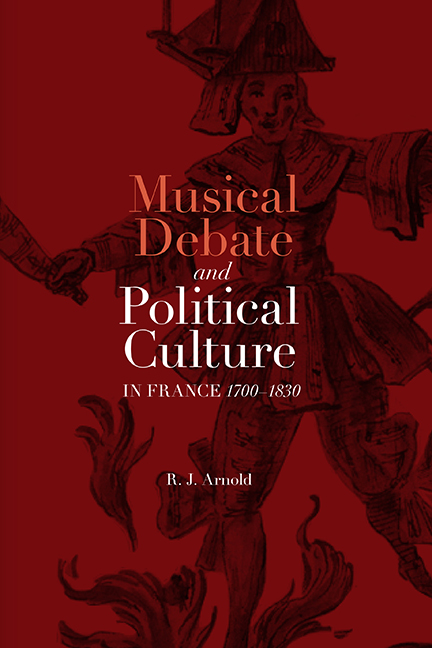Book contents
- Frontmatter
- Contents
- List of Illustrations
- Introduction
- 1 Parallels, Comparisons and Ripostes: The Raguenet–Lecerf Controversy, 1702–32
- 2 Spectators, Satirists and Sectarians: The Ramiste–Lulliste Querelle, 1733–51
- 3 'A Vast Negotiation': The Querelle des Bouffons, 1752–54
- 4 The Spirit of Contradiction: The Gluckiste–Piccinniste Querelle, 1774–88
- 5 A Revolutionary Interlude: 1789–1800
- 6 The End of the Party: New Avenues for Musical Dispute, 1800–30
- Conclusion
- Select Bibliography
- Index
- Music in Society and Culture
1 - Parallels, Comparisons and Ripostes: The Raguenet–Lecerf Controversy, 1702–32
Published online by Cambridge University Press: 29 May 2021
- Frontmatter
- Contents
- List of Illustrations
- Introduction
- 1 Parallels, Comparisons and Ripostes: The Raguenet–Lecerf Controversy, 1702–32
- 2 Spectators, Satirists and Sectarians: The Ramiste–Lulliste Querelle, 1733–51
- 3 'A Vast Negotiation': The Querelle des Bouffons, 1752–54
- 4 The Spirit of Contradiction: The Gluckiste–Piccinniste Querelle, 1774–88
- 5 A Revolutionary Interlude: 1789–1800
- 6 The End of the Party: New Avenues for Musical Dispute, 1800–30
- Conclusion
- Select Bibliography
- Index
- Music in Society and Culture
Summary
THE dispute that is the subject of this chapter was on the smallest possible scale: a disagreement, and at times a highly personal one, between two obscure provincial gentlemen. Yet, according to one way of looking at events, it gave rise to a series of overlapping, intellectually linked controversies that continued, mounting in size and intensity, until at least the Revolution. The present study intends to some extent to depart from the notion that this should all be seen as one long argument and will emphasise the particularity of each episode, but it is nonetheless clear that, after the first decade of the eighteenth century, discussions around opera customarily took on a quarrelsome tone, or were at least framed by observers in antagonistic, binary terms; this vexatious spirit was regarded as uniquely characteristic of the French reception of opera and, in the view of many commentators, served to retard the progress of the form well into the 1800s.
Opera had been debated in France for a long time, and with considerable vigour. But these previous manifestations had tended to revolve around the viability of opera as a genre, comparing it against spoken tragedy and questioning its adherence to standards of verisimilitude and good taste; the premise of such arguments was purely literary. This line of thinking was far from exhausted by 1700 and was forcefully summed up in a widely read poem of 1711 by Pierre de Villiers which argued that while there was nothing wrong with music in itself, its insertion into the drama perverted the essential purities of theatrical tragedy; this excited a response from Antoine-Louis Le Brun. Attacks on the invraisemblance of opera continued to be heard through the eighteenth century and beyond, although tending increasingly to be the preserve of irreconcilable music-haters. The querelles that are the focus of this study were distinct from this narrowing line of debate: they accepted the validity and permanence of opera as a genre and, although they might stray into issues of dramaturgy and literary style, they addressed themselves principally – albeit with varying degrees of technical engagement – to the music. For most participants, it was no longer a question of whether opera should be allowed to survive, but of what models it should follow in order to exercise its emotional and intellectual impact with maximum effectiveness.
- Type
- Chapter
- Information
- Publisher: Boydell & BrewerPrint publication year: 2017

